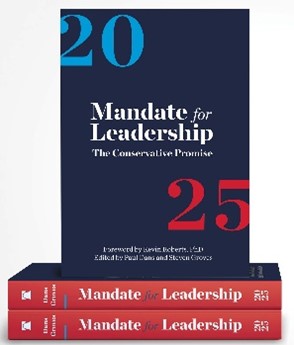Labor Watch
A Mandate for Labor Error: Conclusion
 Mandate for Leadership: The Conservative Promise presents a comprehensive, ready-made agenda for the next president—just as the Heritage Foundation has done every four years since the 1980 presidential election. Credit: Shop Heritage. License: https://herit.ag/3M7t4UA.
Mandate for Leadership: The Conservative Promise presents a comprehensive, ready-made agenda for the next president—just as the Heritage Foundation has done every four years since the 1980 presidential election. Credit: Shop Heritage. License: https://herit.ag/3M7t4UA.

A Mandate for Labor Error
Statism from the Right | Big Labor Radicalizes
Strange Bedfellows | Coming to Policy at Last | Conclusion
Conclusion
Lest anyone think I am making mountains out of a molehill, American Compass’s influence over labor policy in a Heritage Foundation-led coalition (and, if the coalition gets its way, the next president of the United States) merely shows how deeply its statist-funded errors have become embedded in formerly free-enterprise institutions.
How has it come to this? The Taft-Hartley consensus—making union membership voluntary, subjecting unions to government oversight, and protecting consumers and the economy from labor strife—worked. It apparently worked so well that conservatives forgot why they supported it. Most American workers will never face the prospect of being compelled to pay dues to a functionally political organization whose politics they oppose to get or keep a job—a prospect made even more remote by the Supreme Court’s 2018 decision Janus v. AFSCME, which made the entire government sector functionally right to work.
The Labor Management Reporting and Disclosure Act and anti-crime legislation have made substantial gains in combating union corruption and subjecting union activities to public scrutiny in exchange for their government-granted benefits. And while private-sector strikes today lack the power to cause the economic disruptions of 1946, to the great benefit of consumers and workers, public-sector strikes and de facto strikes, like teachers unions’ contemptible refusal to return to in-person work during COVID-19, are another matter.
The Taft-Hartley consensus served the factions who make up the conservative movement. For as long as it has been an identifiable thing, the conservative movement has represented the workers and owners of the small business world. It is not for nothing that the National Federation of Independent Business, a major trade group for small businesses, gives overwhelmingly to Republican candidates.
This has not changed in the post-2016 era except on the margins: The vast majority of Republicans voted both for Mitt Romney in 2012 and for Donald Trump in 2016 and 2020, and Trump won every state that Romney won in 2012 in his first campaign. He would lose Georgia and Arizona in 2020, but both only narrowly. Claims of a fundamental, mass realignment of the proletariat to the GOP and the small business/managerial sector to the Democratic Party are not borne out by electoral evidence. At most, such shifts are subtle and marginal. And where the Taft-Hartley consensus has been weakest—among Congressional Republicans from New York, New Jersey, Pennsylvania, and other highly unionized forced-dues states like Reps. Smith and Fitzpatrick—deviation from it has rightly been seen as a moderate’s concession to a liberal electorate, not an upholding of conservative principle.
While conservatives have mostly stayed the same, Big Labor has changed in the 75 years since Taft-Hartley, becoming less hospitable to social conservatism and the market economy. Causes include the growing power of government-worker unions within the union movement, the rise of 1960s radicals to positions of union office, the nationalization of popular union-backed policies like the 40-hour workweek, the rise of overseas competitors after they rebuilt from World War II, and the end of the Cold War results in the kneecapping of labor’s centrist faction.
Seeking to improve workers’ lot is noble, and credit is due to those seeking to do that, even when they’re in error. But the game of politics and policy is zero-sum. That means that any action that strengthens union bosses hurts independent businesses and their workers, and aids conservatism’s adversaries. The American Compass types have not presented a plausible legislative path either to getting unions out of politics or getting them out of the hands of woke activists—which would be difficult, if the difficulty of extracting the Mafia from the 20-century labor movement is any indication.
For the sake of American workers and businesses, the next president should not follow the course laid out by American Compass.
This article was published in the May/June 2023 issue of Capital Research magazine.



